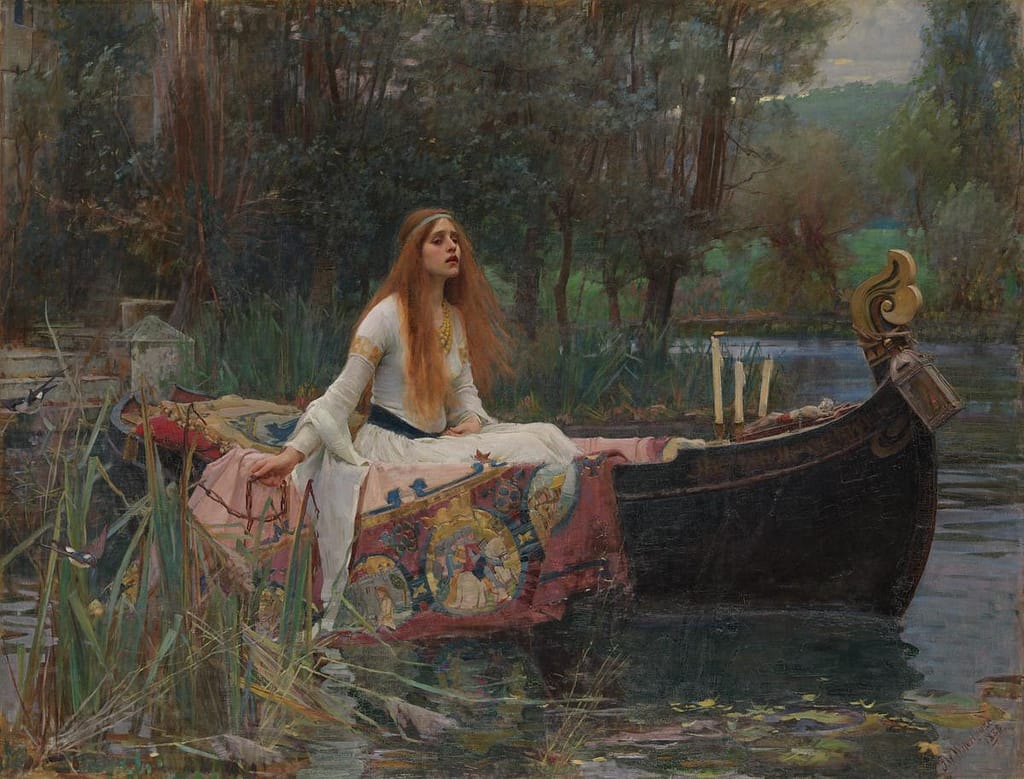Art, in its many forms, has a remarkable ability to transcend time and mediums, connecting artists across generations. Alfred Lord Tennyson, John William Waterhouse, and Loreena McKennitt belong to different eras and artistic disciplines, but these three artists share a common muse—the mysterious and tragic “Lady of Shalott.”
Let’s take a look at the three artists and the art that was inspired by this mystical lady.
Who is the Lady of shalott?
Elaine of Astolat, also known as Elayne of Ascolat (and other variations of her name) is a character in Arthurian legend. She is a lady from the castle of Astolat who dies of her unrequited love for Sir Lancelot. There are multiple versions of her story:
- La Damigella di Scalot, a 13th century Italian novella in which the Lady of Scalot dies of unrequited love for Sir Lancelot
- Mort Artu, an early 13th century prose in which the Lady of Escalot dies of unrequited love for Lancelot and drifts down a river to Camelot
- Stanzaic Morte Arthur , a 14th-century English poem in which she is known as the Maid of Ascolat
- Le Morte d’Arthur, a 15th century compliation of Arthurian stories by Sir Thomas Malory. In Chapter 19, of Book 18, Malory tells the tale of the Fair Maid of Astolat and how she died for Sir Lancelot’s love
Alfred Lord Tennyson – A Poem of vivid imagery
British Romantic poet Alfred Lord Tennyson wrote two lyrical ballads of the Lady of Shalott. The first was published in 1832 and a revised version was published in 1842. Tennyson sets the story on an island in the river flowing down to Camelot. The poem adds an element of mystery in the form of a curse. The curse forbids The Lady of Shalott from looking directly through a window to the outside world. She is confined to her tower and must weave what she sees of the world through reflections in a mirror.
Tennyson’s poem is an excellent example of Victorian romanticism. It contains powerful visual imagery of a young woman trapped in a tower and then dying as she floats down the river to Camelot. Tennyson portrays a vibrant and colorful world outside the tower. While inside the tower, there are only four gray walls. The Lady of Shalott is a melancholy poem of yearning and desperation.
Tennyson’s poem inspired many painters, especially the Pre-Raphaelites, as well as other authors and artists. But it is Tennyson’s poem that is the quintessential Arthurian and tragic story of the Lady of Shalott.
John William Waterhouse – a Visual Masterpiece
Fast forward to the late 19th and early 20th centuries, and John William Waterhouse picks up the Lady’s thread. He first painted her in 1888. His painting portrays the beginning of Part IV of Tennyson’s poem. The Lady of Shalott has defied the curse and looked upon Lancelot and Camelot. She is sitting in a boat, on the tapestry she has woven. She is holding a chain in one hand, ready to let go. There are three candles, representing Birth, Life and Death. Birth and Life are no longer burning and The Lady of Shalott appears ready to blow out Death. Behind her are steps that lead to her tower.
Waterhouse’s visual masterpiece resonates with the same melancholy emotions of yearning and desperation that Tennyson’s poem evokes. The painting breathes life into Tennyson’s narrative, depicting the colorful world the Lady has been denied and captures the loneliness and resignation of breaking her curse. Waterhouse’s “The Lady of Shalott” is arguably the most famous illustration of Tennyson’s poem. And, it is the most famous of Waterhouse’s paintings.

Loreena McKennitt – A spellbinding Musical interpretation
Fast forward again to more modern times, and Loreena McKennitt creates a spellbinding musical interpretation to the Lady of Shalott.
McKennitt’s unique style combines elements of Celtic and classical music. She is a renowned harpist, and her main instrument is a Celtic harp, which she uses to create beautiful and haunting melodies. She often uses literary works as sources of lyrics.
In “The Lady of Shalott”, McKennitt uses ethereal vocals and haunting instrumentals to take listeners on a journey through the tragic tale. The music mirrors the melancholy emotions of Tennyson’s poem and Waterhouse’s painting. McKennitt’s song is a mesmerizing interpretation of the Lady’s curse, isolation, and death.
Loreena McKennitt’s rendition of The Lady of Shalott is a remarkable and memorable addition to the already rich history of the story. The song resonates across a broad audience, and it taps into our deepest emotions.
Threads of Continuity – a shared fascination with the lady of shalott
Three artists share a common muse – The Lady of Shalott. She is a character who symbolizes feminine mystique and artistic expression. The tower, the loom, the magical web and her death—these motifs echo through Tennyson’s poem, Waterhouse’s painting, and McKennitt’s song, creating a continuous visual and emotional thread.
Tennyson, Waterhouse, and McKennitt all speak a shared language of emotion. The yearning for freedom, the inevitability of destiny, and the poignant beauty of a life lived in isolation resonate across their works. It’s a testament to the universality of human emotions captured through artistic mediums.
Tennyson, Waterhouse, and McKennitt, separated by time, are three artists who share a common muse. The Lady of Shalott’s allure continues to weave its magic. She reminds us of the enduring power of storytelling and artistic expression that transcends the boundaries of time and medium.






